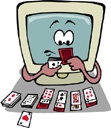
Spider Solitaire became widely popular after Microsoft included it in their Windows 98 package. Spider is a particularly interesting version of solitaire because it involves the use of two decks of cards rather than the standard single deck common to many solitaire varieties.
Like most other solitaire games, the goal of Spider Solitaire is to remove all the cards from the “tableau” by forming “runs” or sets of cards in a specific order.
How to Play Spider Solitaire
To play Spider Solitaire (without the aid of a computer) take two standard decks of 52 cards (Jokers removed) so that you have 104 cards in your stack. Deal a hand of Spider Solitaire by laying down ten rows of cards (the “tableau”) — the first four rows from the left side of the tableau contain six cards (each row has only the top card showing) and the last six rows contain five cards for a total of 104 cards (with ten showing “face up”). The other fifty cards become your “stock”.
Another reason for the popularity of Spider Solitaire is the player’s ability to change the game’s difficulty by changing the rules. Open ended games are always more fun and offer a more challenging pursuit for the player.
Because traditional Spider Solitaire is a difficult game (the number of cards increases the difficult considerably) the player has the option of playing with a limited number of suits. The standard suits to play Spider Solitaire with are Spades or Spades and Hearts together. This makes the game easier, though it requires more decks of cards to create the 104 card setup.
Once you’ve decided what difficulty level you want to play at, gathered your cards, and built the initial tableau, you should start building runs. The runs in Spider Solitaire move downward from King to Ace (Kings high, Aces low). Because there are 104 cards and the runs are made up of thirteen cards, there will naturally be eight “foundations” where you place the runs when you’ve completed them. The game is won when you’ve built all eight foundations running from King down through Ace.
All foundation building really happens in the tableau itself, similar to traditional solitaire — this means that the eight “foundation spots” won’t really be a big part of the game until you’re ready to drop a run into its home. Once a card is “exposed” (meaning it is face up) you can move it from the end of a tableau into another game space if and only if this move forms part of a run. Remember that runs in Spider Solitaire are in descending order, so you can play a two on a three, or a Jack on a Queen, etc.
Spider Solitaire players are also allowed to move particular run as a unit onto another tableau column — but only if the two runs are of the same suit. This is why to make the game of Spider Solitaire easier, all it takes is limiting the number of suits in play.
Computer versions of Spider Solitaire automatically move runs into the appropriate foundation spot — if you’re playing along at home, you’ll need to sweep these runs into their proper spot as you go. The resulting empty spaces in the tableau can be filled up with any card you’d like, or another “run” from another tableau column. Eventually, you will run out of moves (no matter how easy of a game you’re playing) and you should pull ten cards from your stock, dealing another card to each of the tableau columns.
Just to make the game even more infuriating, you are required to fill an empty spot in the tableau before you deal out of the stock — often this means breaking up a run in progress just to move forward.
Spider Solitaire Variations
As mentioned earlier, there are plenty of variations in the game of Spider Solitaire. You can alter the number of decks used to play a longer game, or you can alter the suits in play for an easier or harder game. When you change the number of decks used, you’re playing either Gigantic Spider or some other superlative. When you alter the number of suits, you simply refer to these games by the number of suits in play — for instance, one suit, two suits, three suits, etc.
Spider Solitaire Strategy
A few strategy notes before you head off to play an exciting round of Spider Solitaire — don’t forget that moving a run from the tableau into the foundation area will keep those cards completely out of play for the rest of the game. Also — when you have an empty space, you don’t have to instantly fill it with a card that you plan to use to build a run. You can use that empty space to “cycle through” cards in the game in order to set yourself up for victory.
Spider Solitaire may have exploded in popularity after its inclusion in a version of Microsoft’s Windows operating system, but you don’t have to be running Windows to play. Stock up on additional decks of cards and try out this very adaptable game of Solitaire today.
More Solitaire Articles: